Pilot’s Purple Heart Past
Use controls above or click here to open this Hometown Heroes podcast in a new window
92-year-old John Chavez of Orangevale, CA appears on episode #479 of Hometown Heroes, airing July 7-9, 2017. A native of Fresno, CA, Chavez carries a unique military legacy. Having served overseas in World War II, the Korean War, and the Vietnam War puts him in a pretty exclusive group.
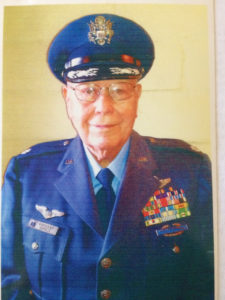
It’s not unusual to see this many medals on a Lt. Col.’s uniform. But how many retired Air Force pilots can wear the Combat Infantry Badge?
Even more rarified air would be evident if you stuck him in a room full of other Air Force retirees. How many decorated bomber pilots are authorized to wear the Combat Infantry Badge? And perhaps the most eyebrow-raising detail of his three decades in our Armed Forces is that he logged more than 22,000 hours in the air, never knowing that he was taking some old stowaways on that worldwide tour: pieces of shrapnel inside his head, courtesy of a German machine gun in Forbach, France in February, 1945. Listen to Hometown Heroes for his memories of growing up in California’s agriculturally-rich San Joaquin Valley, where he and his brother walked three miles to school each day from their rural home that was not connected to electrical power. “We had a wood stove and we had a pump outside for water,” you’ll hear him remember. “And a two-holer outside for an outhouse.” Nearby Chandler airport fed his affinity for aviation. He remembers walking over to pick pilot’s brains, and he has vivid memories of flying model airplanes that he built with his brother and friends. Nearing the end of his junior year at Central High School in 1943, Chavez was drafted into the Army. He asked his teachers for extra schoolwork so he could finish the rest of the term’s worth of material before reporting for duty. After initial training in Monterey, CA, he was sent to Fort Mason in San Francisco, where a friend named Boyle suggest they try to become aviation cadets. You’ll hear Chavez explain the tests he had to pass to qualify for the program, and how his dream of becoming a pilot carried him to Denver, CO and Bozeman, MT before coming to a screeching halt when the planned invasion of Normandy necessitated more men for the infantry.
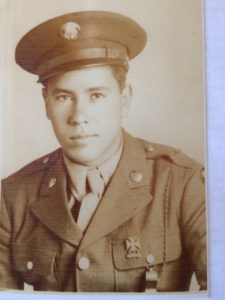
20-year-old John Chavez in 1944. For more photos, visit the Hometown Heroes Facebook page.
Camp Adair in Corvallis, OR is where he had to go next, training with two entire divisions (28,000 men) which would soon be heading overseas. After brief stops in Missouri and Massachusetts, he found himself on the USS West Point, a converted cruise ship, journeying from Boston all the way to southern France, where he landed on December 16, 1944. Within days, he would be on the snow-covered front lines as a Browning Automatic Rifle (BAR) man with Company I, 276th Infantry Regiment, 70th Infantry Division.
You’ll hear him describe some of his early action, which included heavy casualties suffered by his company in the battles for Wingen and Oetingen. The 20-year-old had dealt with brutal weather conditions and intense opposition, but when the 276th arrived in Forbach in late February, 1945, he encountered a situation that nearly claimed his life. “We could see the guys and the machine gun sitting way up in the corner,” he says of a spot in Forbach during a time where combat was moving literally house to house. “Somebody said we gotta move over to this house here.” If the soldiers progressed across that opening one at a time, they had a better chance of making it to the waiting door without being struck by machine gun fire. Loaded down with hand grenades, his 22-pound BAR, 12 magazines of ammunition, and the rest of his gear, Chavez couldn’t run very fast. When another soldier made a break for it at the same time, those side-by-side Americans gave the German machine gunner a bigger target.
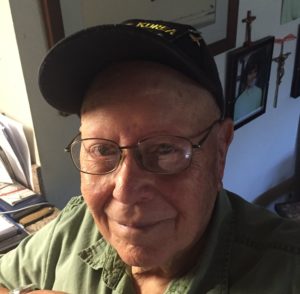
Scars on John Chavez’s forehead remind him of where the bullet that penetrated his helmet in February, 1945. In 2007, he learned he also still has shrapnel underneath the surface.
“When it hit me, it knocked me out,” Chavez says of a machine gun bullet that came right through the front of his helmet. “I fell forward in the door, and when they saw the helmet and they saw the blood and all that, they thought I was dead and they just kept on going.”
An older French couple came to his rescue, wiping up some of the blood, and helping him back to where American medics were. He would later learn that the same burst of machine gun fire that nearly took his life did kill three men behind him, after striking a grenade one soldier was carrying. John’s skull was cracked above his left eye, and seven decades later, he’s still carrying shrapnel beneath the skin, but he was back in combat within a week of getting wounded. In March, still in Forbach but now on the northern end, he was wounded a second time. In the dark of night, enemy soldiers came over the small ridge separating German and American forces. Hearing them clambering over a fence, Chavez opened up on them with his BAR, and the enemy soldiers returned fire.
“The next thing I know, one of the bullets hit me,” John says, pointing to the center of his left hand. “All these bones were broken.”
Bleeding profusely, and in a great deal of pain, Chavez was driven by jeep to a nearby aid station, where he was bandaged up before being taken to the 93rd Evacuation Hospital. When he woke up the next day, the setting left him momentarily confused and wondering if his injuries had been worse than he imagined.
“I look over there and everything was white, and I didn’t know where I was,” you’ll hear him recall. “It could have been heaven, I don’t know. Really!”
When two nuns approached, their arched coifs evoked angel’s wings, adding to the elysian motif. As he transferred from hospital to hospital during his recovery, he came face to face with many soldiers who had suffered more debilitating injuries than his. You’ll hear him describe some of the other patients and what had happened to them, including a man who lost both legs and both arms. When that man had a book to read, John sat by his bedside and turned the pages for him.
He returned to his unit again before the end of the war, and remained in Europe until 1946. He reconnected with a young lady he had dated briefly before the war. Married in May, 1946, John & Pat enjoyed nearly 65 years of marriage before her passing in 2011. More than 20 of those years were spent with John in uniform, because in 1949 he took advantage of an opening for anyone who had gone through aviation cadet training to reapply for the program. His dreams of becoming a pilot were fulfilled, and Pat, now a young mother, persevered as John deployed overseas in 1951. He flew 37 combat missions over North Korea as a B-29 pilot with the 343rd Bomb Squadron, operating out of Yokota Air Force Base in Japan as part of the 98th Bomb Wing.
One memorable mission saw his Superfortress struck with anti-aircraft fire, losing two of the bomber’s four engines. Listen to Hometown Heroes to hear why the alternate runway they were forced to land on was lit up by car headlights. Chavez spent six years flying B-47 Stratojets, and in June 1965, he made history in a B-52 Stratofortress. The first time that legendary bomber saw combat was Operation Arc Light, and while Pat and their three children were back home in the U.S., John piloted his B-52 from Guam in the first bombing mission over Vietnam.
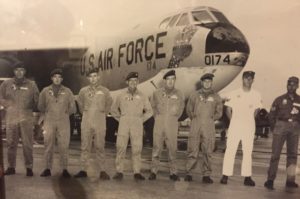
John (left) meets regularly with two other members of his B-52 crew from Vietnam who know live near him in the Sacramento area.
Chavez went to great lengths to communicate with his children during his two separate tours in the Vietnam War, including recording audio tapes and sending them back home. Two members of that pioneering B-52 crew live near him in the Sacramento area, and the trio continues to meet on a monthly basis. After retiring from the Air Force in 1970, he spent 19 years working for the Federal Aviation Administration as an inspector and pilot. His youngest daughter is a longtime flight attendant, but no assignment she’s had was more fulfilling than serving as her father’s guardian on a trip from Phoenix to Washington, D.C. with Honor Flight Arizona. The World War II, Korean War, and Vietnam Veterans memorials all held special significance for John, who lost friends in all three conflicts. At age 92, Chavez is thankful for all the twists and turns his unique story has taken, and proud of what he has accomplished.
“I’m most proud that I served my country to the fullest,” he says. “I made it through.”
Watch the video below for Chavez’s description of the wounds he suffered in Forbach in 1945, and if you ever spy three gentlemen with B-52 hats sitting down for a meal in the Sacramento area, see if you can coax the other two into telling you some stories about their pilot that John Chavez was too humble to share.
—Paul Loeffler


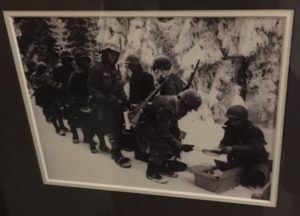
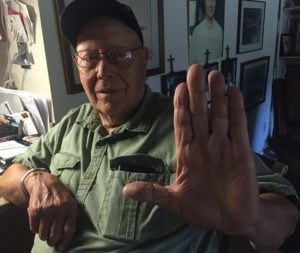
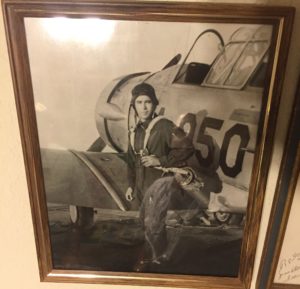
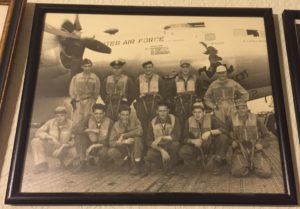
God Bless Ametica, John Chavez, & Men like unto him!
GOD Bless John Chavez and his family!!! On behalf of his mother Rosa Váldez Juaréz
Pingback: Hometown Heroes Radio » Veterans Day 2020